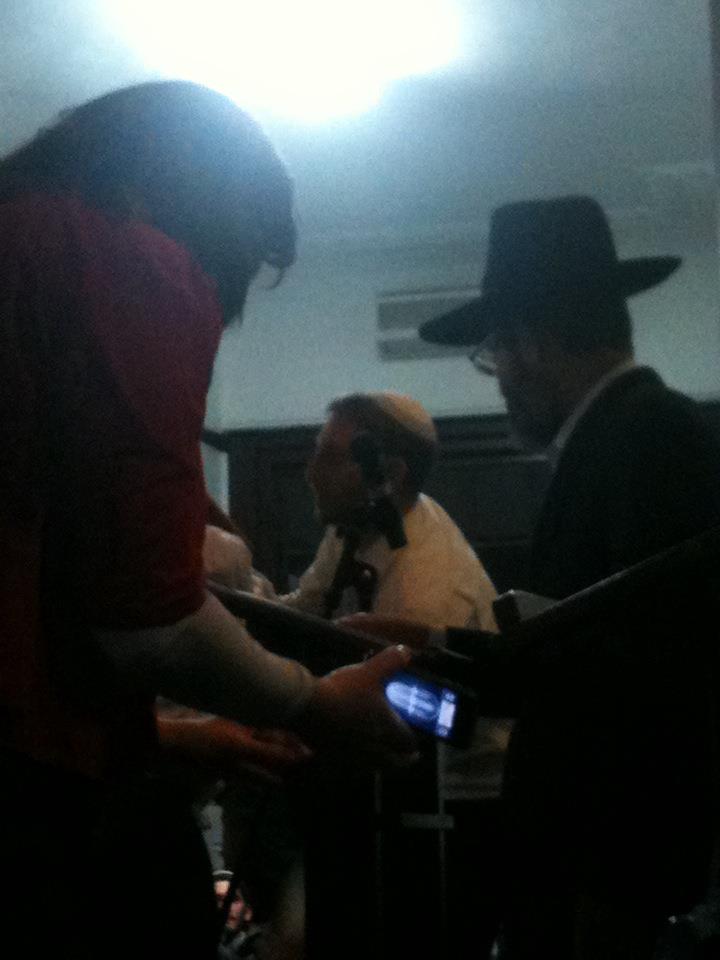Rabbi Lawrence Keleman on Tisha B’Av
 Last night I had the privilege to be able to hear Rabbi Lawrence Keleman of Neve Yerushalayim (where I went to seminary) speak on the subject of Tisha B’Av.
Last night I had the privilege to be able to hear Rabbi Lawrence Keleman of Neve Yerushalayim (where I went to seminary) speak on the subject of Tisha B’Av.
He started out by questioning why the Second Temple was destroyed. The First Temple was destroyed because the Jews were engaged in idolatry, adultery, and murder. The Second Temple’s destruction was considered to be much worse. We are told that the Jews in the time of the Second Temple kept the mitzvot. They were nice enough to each other to their faces. Yet, it was destroyed because of sinas chinam, baseless hatred. How can this be?
He began his explanation by saying we all too often live in a two dimensional world when we should live in a three dimensional world. The two-dimensional world is one of materialism and superficiality while the third dimension is in spirituality. The example he gave was one about greeting others. Rabbi Yochana Ben Zakkai used to be known for greeting everyone – including non-Jews – first. However, if someone does not greet you back when you greet them it is as if they are a thief. Therefore, we are cautioned not to greet someone who will not greet us back because it will turn them into a thief – akin to placing a stumbling block before the blind. So how could Rabbi Yochana Ben Zakkai greet everyone? A talmid chacham (Torah scholar) should greet everyone because the talmid chacham is like a living moral compass. He lives in the spiritual realm also – he lives in all three dimensions. He helps us to see that third dimension.
Most of the time, unfortunately, we don’t see the third dimension. It affects us and we don’t even realize it. Fear and anxiety are the result of not living in the third dimension. The third dimension is one of connection, of relationship. Closing ourselves off from relationship causes us to live in fear and anxiety.
There are three types of relationships:
1) Relationship with G-d. This means doing the mitzvot. Hashem gives us 613 mitzvot to do. It is as if He has written us a love letter. The least we can do is to say, “Wow! These simple things we can do to make our Beloved happy – we must do them!” Even missing little things – especially missing the little things – causes us to feel anxiety. Failure to wash hands after having a haircut, for example, causes anxiety for 3 days. Failure to wash hands after cutting your nails causes anxiety for 1 day. And so on and so forth. In our relationships, it’s the little things that count for the most.
2) Relationships with other people. This means focusing on relationships and connection. Rabbi Keleman gave the example of a couple who had a little fight and the husband came to him after not speaking with his wife for three weeks. He called the wife and told her, “Your husband wants so much to apologize, but he is afraid that if he does so you will use it to jump on him.” She agreed not to jump on him but admitted she had been afraid to apologize because she thought her husband would criticize her. So Rabbi Keleman went back to the husband and said, “Your wife wants so much to apologize but she is afraid you will criticize her.” He agreed not to be critical. The couple was reconciled. The key to relationships is in that connection.
3) Relationship with self. We all have a body and a soul. We need to take time for ourselves to work on the relationship between our body and our soul. Just because you study Torah all the time does not mean you are excused from spending time alone and concentrating on yourself. If you don’t, you will have anxiety and you will not know where it is coming from.
When we take this knowledge and apply it to the story of Kamtza and bar Kamtza, we gain a new insight into the destruction of the Temple. You see, a man was having a party and he wanted to invite his best friend Kamtza. Instead, his servant mistakenly invited his mortal enemy, bar Kamtza. Seen through the lens of relationships, we can answer the question of why bar Kamtza would even accept such an invitation in the first place. Imagine bar Kamtza encounters the servant of his worst enemy. The servant tells him, “My master wants to invite you to a party.” Bar Kamtza says, “Who? Me? But I’m his worst enemy! There must be a mistake.” “Oh no, sir, my master never makes a mistake! He swears you’re his very best friend and you must come to his party.” Bar Kamtza gets to thinking, “Wow, he must want to reconcile! After all these years!” And all the fear that comes from disconnecting melts away.
So bar Kamtza shows up at the party. The host comes in to see his worst enemy sitting in his living room. ”Get out!” he tells him. “But you invited me! At least let me stay – I’ll even pay for my food and drink.” bar Kamtza says. ”No way! Get out!” shouts the host. “Please! I’ll even pay for half the party! Only don’t embarrass me in front of all these people…!” “No… GET OUT!” says the host. “I’ll pay for the whole party!” offers bar Kamtza, in a desperate last-ditch attempt…. After which the host tosses him out onto the street. And the whole time none of the rabbis in the room say anything. Hundreds of rabbis, all the top Torah scholars in the realm, are there and not one of them says anything to stop it. The moral compass is broken. “I guess,” bar Kamtza concludes, “That there is no third dimension after all.” And this leads to the destruction of the Temple. That is sinas chinam. That is baseless hatred.
If we want the Third Temple, we have to strive for connection. We have to focus on connecting with Hashem and with others and with ourselves. We have to tap into that third dimension.
Read More







